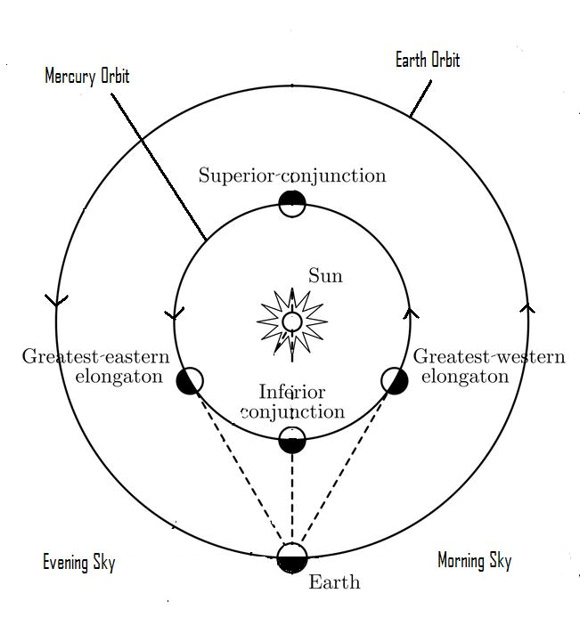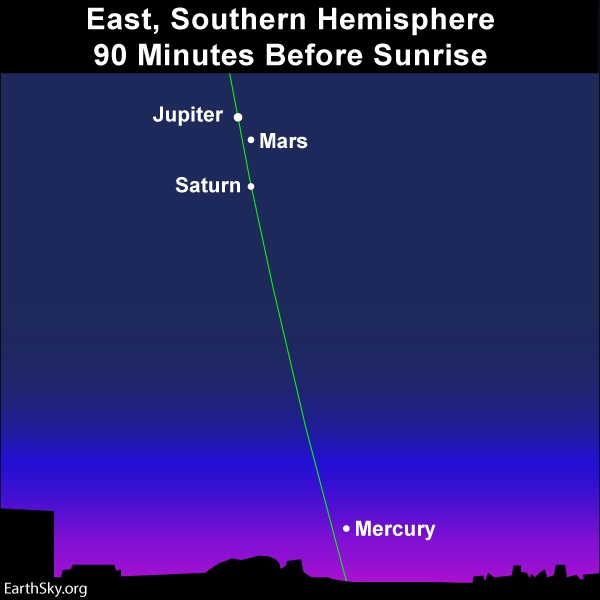
Mercury, the solar system’s innermost planet, reaches its maximum elongation from the sun for the year on March 24, 2020. This world now resides a whopping 27.8 degrees west of the sun, placing Mercury in the morning sky before sunrise. Looking ahead, Mercury will reach its maximum elongation in the evening sky on October 1, 2020 (25.8 degrees east of the sun).
Mercury presents 6 greatest elongations in 2020, three in the evening sky and three in the morning sky. Because Mercury’s orbit is quite eccentric (oblong), Mercury’s greatest elongations are far from equal throughout the year, varying from about 18 to 28 degrees. We list all of Mercury’s greatest elongations for 2020:
Mercury greatest elongations in 2020
2020 February 10: 18.2 degrees east of the sun (evening sky)
2020 March 24: 27.8 degrees west of the sun (morning sky)
2020 June 4: 23.6 degrees east of the sun (evening sky)
2020 July 22: 20.1 degrees west of the sun (morning sky)
2020 October 1: 25.8 degrees east of the sun (evening sky)
2020 November 10: 19.1 degrees west of the sun (morning sky)

An inferior planet – a planet that orbits the sun inside of Earth’s orbit – appears in the evening sky at its greatest eastern elongation, and in the morning sky at its greatest western elongation. The two inferior planets are Mercury and Venus, residing at a mean distance of 0.387 and 0.723 astronmical units from the sun, respectively.
You might think right now should present the best time to see Mercury in 2020, given that Mercury swings out at to its maximum elongation from the sun for the year on March 24, 2020. Yes, that’s the case if you live in the world’s Southern Hemisphere. But for those living at northerly latitudes in the Northern Hemisphere, this is Mercury’s poorest apparition in the morning sky for this year. If you live as far north as Alaska, you probably won’t see Mercury at all – even with binoculars – where the sun and Mercury rise at almost the same time.
In short, the farther south you live, the more time before sunrise that Mercury rises. We give the approximate rising times for Mercury at various latitudes (given a clear and obstructed horizon in the direction of sunrise):
40 degrees north latitude: Mercury rises about one hour before the sun
Equator (0 degrees latitude): Mercury rises about 1 1/3 hours before the sun
40 degrees south latitude: Mercury rises about 2 1/4 hours before the sunWant more specific information? Click here for a sky chart.
You might wonder why the extreme difference between the Northern and Southern Hemispheres for viewing Mercury in the morning sky. It’s because it’s now early spring in the Northern Hemisphere – yet early autumn in the Southern Hemisphere. The recent equinox on March 20, 2020, was the Northern Hemisphere’s spring equinox and the Southern Hemisphere’s autumn equinox.
Read more: Does the equinox sun rise due east and set due west?
At sunrise on and around the spring equinox, the ecliptic – the roadway of the planets on the sky’s dome – hits the sunrise horizon at its shallowest angle for the year. Therefore, Mercury – even at its greatest morning elongation – never gets far from the sun’s glare around the spring equinox, so it sits low in the glow of morning twilight. Contrast the sky chart for about 40 degrees north latitude at top with the chart below at 40 degrees south latitude.

On early autumn mornings the ecliptic -the pathway of the planets – hits the horizon at a steep angle. Therefore, in the Southern Hemisphere, where it’s now autumn, the planet Mercury is easier to see than at mid-northern latitudes. The Northern Hemisphere view can be seen on the feature chart at top.
At sunrise on and around the autumn equinox, the ecliptic – the planetary pathway – hits the sunrise horizon at its steepest angle for the year. Therefore, Mercury at its greatest elongation soars higher up in the sky before sunrise at southerly latitudes, showcasing the Southern Hemisphere’s best morning apparition of Mercury for the year.
If you live at mid-northern latitudes, don’t give up entirely on spotting Mercury before sunrise. Get up before dawn to view the other three morning planets: Jupiter, Mars and Saturn. A line from Jupiter through Saturn and down to the horizon shows Mercury’s approximate rising point on the horizon. Scan this spot on the horizon with binoculars about 45 to 60 minutes before sunup, and you just might catch Mercury, the most elusive planet of the early morning sky.
On March 24, 2020 – on the same date that Mercury swings out to its greatest morning elongation – Venus reaches its greatest elongation in the evening sky. Because this is an evening event in the springtime sky for the Northern Hemisphere, the northerly latitudes enjoy the better view of Venus in the evening sky than do the southerly latitudes.
Read more: Venus’ greatest evening elongation on March 24
Bottom line: Mercury, although sitting way below the planets Mars, Jupiter and Saturn in the morning sky, nonetheless swings out to its farthest angular distance from the sun for the year on March 24, 2020.
from EarthSky https://ift.tt/2UcHgAU

Mercury, the solar system’s innermost planet, reaches its maximum elongation from the sun for the year on March 24, 2020. This world now resides a whopping 27.8 degrees west of the sun, placing Mercury in the morning sky before sunrise. Looking ahead, Mercury will reach its maximum elongation in the evening sky on October 1, 2020 (25.8 degrees east of the sun).
Mercury presents 6 greatest elongations in 2020, three in the evening sky and three in the morning sky. Because Mercury’s orbit is quite eccentric (oblong), Mercury’s greatest elongations are far from equal throughout the year, varying from about 18 to 28 degrees. We list all of Mercury’s greatest elongations for 2020:
Mercury greatest elongations in 2020
2020 February 10: 18.2 degrees east of the sun (evening sky)
2020 March 24: 27.8 degrees west of the sun (morning sky)
2020 June 4: 23.6 degrees east of the sun (evening sky)
2020 July 22: 20.1 degrees west of the sun (morning sky)
2020 October 1: 25.8 degrees east of the sun (evening sky)
2020 November 10: 19.1 degrees west of the sun (morning sky)

An inferior planet – a planet that orbits the sun inside of Earth’s orbit – appears in the evening sky at its greatest eastern elongation, and in the morning sky at its greatest western elongation. The two inferior planets are Mercury and Venus, residing at a mean distance of 0.387 and 0.723 astronmical units from the sun, respectively.
You might think right now should present the best time to see Mercury in 2020, given that Mercury swings out at to its maximum elongation from the sun for the year on March 24, 2020. Yes, that’s the case if you live in the world’s Southern Hemisphere. But for those living at northerly latitudes in the Northern Hemisphere, this is Mercury’s poorest apparition in the morning sky for this year. If you live as far north as Alaska, you probably won’t see Mercury at all – even with binoculars – where the sun and Mercury rise at almost the same time.
In short, the farther south you live, the more time before sunrise that Mercury rises. We give the approximate rising times for Mercury at various latitudes (given a clear and obstructed horizon in the direction of sunrise):
40 degrees north latitude: Mercury rises about one hour before the sun
Equator (0 degrees latitude): Mercury rises about 1 1/3 hours before the sun
40 degrees south latitude: Mercury rises about 2 1/4 hours before the sunWant more specific information? Click here for a sky chart.
You might wonder why the extreme difference between the Northern and Southern Hemispheres for viewing Mercury in the morning sky. It’s because it’s now early spring in the Northern Hemisphere – yet early autumn in the Southern Hemisphere. The recent equinox on March 20, 2020, was the Northern Hemisphere’s spring equinox and the Southern Hemisphere’s autumn equinox.
Read more: Does the equinox sun rise due east and set due west?
At sunrise on and around the spring equinox, the ecliptic – the roadway of the planets on the sky’s dome – hits the sunrise horizon at its shallowest angle for the year. Therefore, Mercury – even at its greatest morning elongation – never gets far from the sun’s glare around the spring equinox, so it sits low in the glow of morning twilight. Contrast the sky chart for about 40 degrees north latitude at top with the chart below at 40 degrees south latitude.

On early autumn mornings the ecliptic -the pathway of the planets – hits the horizon at a steep angle. Therefore, in the Southern Hemisphere, where it’s now autumn, the planet Mercury is easier to see than at mid-northern latitudes. The Northern Hemisphere view can be seen on the feature chart at top.
At sunrise on and around the autumn equinox, the ecliptic – the planetary pathway – hits the sunrise horizon at its steepest angle for the year. Therefore, Mercury at its greatest elongation soars higher up in the sky before sunrise at southerly latitudes, showcasing the Southern Hemisphere’s best morning apparition of Mercury for the year.
If you live at mid-northern latitudes, don’t give up entirely on spotting Mercury before sunrise. Get up before dawn to view the other three morning planets: Jupiter, Mars and Saturn. A line from Jupiter through Saturn and down to the horizon shows Mercury’s approximate rising point on the horizon. Scan this spot on the horizon with binoculars about 45 to 60 minutes before sunup, and you just might catch Mercury, the most elusive planet of the early morning sky.
On March 24, 2020 – on the same date that Mercury swings out to its greatest morning elongation – Venus reaches its greatest elongation in the evening sky. Because this is an evening event in the springtime sky for the Northern Hemisphere, the northerly latitudes enjoy the better view of Venus in the evening sky than do the southerly latitudes.
Read more: Venus’ greatest evening elongation on March 24
Bottom line: Mercury, although sitting way below the planets Mars, Jupiter and Saturn in the morning sky, nonetheless swings out to its farthest angular distance from the sun for the year on March 24, 2020.
from EarthSky https://ift.tt/2UcHgAU

Aucun commentaire:
Enregistrer un commentaire